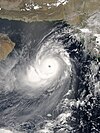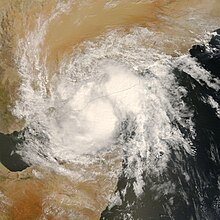Portal:Tropical cyclones
The Tropical Cyclones Portal

A tropical cyclone is a storm system characterized by a large low-pressure center, a closed low-level circulation and a spiral arrangement of numerous thunderstorms that produce strong winds and heavy rainfall. Tropical cyclones feed on the heat released when moist air rises, resulting in condensation of water vapor contained in the moist air. They are fueled by a different heat mechanism than other cyclonic windstorms such as Nor'easters, European windstorms and polar lows, leading to their classification as "warm core" storm systems. Most tropical cyclones originate in the doldrums, approximately ten degrees from the Equator.
The term "tropical" refers to both the geographic origin of these systems, which form almost exclusively in tropical regions of the globe, as well as to their formation in maritime tropical air masses. The term "cyclone" refers to such storms' cyclonic nature, with anticlockwise rotation in the Northern Hemisphere and clockwise rotation in the Southern Hemisphere. Depending on its location and intensity, a tropical cyclone may be referred to by names such as "hurricane", "typhoon", "tropical storm", "cyclonic storm", "tropical depression" or simply "cyclone".
Types of cyclone: 1. A "Typhoon" is a tropical cyclone located in the North-west Pacific Ocean which has the most cyclonic activity and storms occur year-round. 2. A "Hurricane" is also a tropical cyclone located at the North Atlantic Ocean or North-east Pacific Ocean which have an average storm activity and storms typically form between May 15 and November 30. 3. A "Cyclone" is a tropical cyclone that occurs in the South Pacific and Indian Oceans.
Selected named cyclone -
Typhoon Paka, known in the Philippines as Typhoon Rubing, was an extremely powerful and long-lived storm that devastated Guam and the Marshall Islands in December 1997. One of the strongest Pacific typhoons ever recorded in the month of December, Paka was the last tropical cyclone of the 1997 Pacific hurricane and typhoon seasons and the last of a record eleven super typhoons that formed in 1997. Paka, which is the Hawaiian name for Pat, developed on 28 November from a trough well to the southwest of Hawaii. The storm tracked generally westward for much of its duration, and on 7 December it crossed into the western Pacific Ocean. Much of its track was characterized by fluctuations in intensity, and on 10 December the cyclone attained typhoon status as it crossed the Marshall Islands. On 16 December, Paka struck Guam and Rota with winds of 230 km/h (140 mph), and it strengthened further to reach peak winds on 18 December over open waters as the final super typhoon of the year. Subsequently, it underwent a steady weakening trend, and on 23 December Paka dissipated.
Typhoon Paka first impacted the Marshall Islands, where it dropped heavy rainfall and left US$80 million in damages. Later, it passed just north of Guam, where strong winds destroyed about 1,500 buildings and damaged 10,000 more; 5,000 people were left homeless, and the island experienced a complete power outage following the typhoon. Damage on the island totaled US$500 million, which warranted the retirement of its name. Paka also caused minor damage in the Northern Mariana Islands, and overall, the typhoon did not cause any reported fatalities. (Full article...)Selected article -
Deep Depression ARB 02 was a weak yet costly tropical cyclone which caused extensive damage and loss of life in Yemen. The sixth tropical cyclone and third deep depression of the 2008 North Indian Ocean cyclone season, ARB 02 formed in the Arabian Sea on October 19 from the same broader system which would spawn Moderate Tropical Storm Asma in the southern Indian Ocean around that time. Moving generally westward, the depression failed to intensify further, reaching maximum sustained winds of 55 km/h (35 mph). It would weaken, becoming a remnant low on October 23. Later that day, the system's remnants would made landfall near Ash Shihr in eastern Yemen.
The storm sent a plume of moisture throughout the Arabian Peninsula, contributing to dust storms as far north as Iraq. However, the effects were most severe in Yemen, becoming the second-worst natural disaster in the country after deadly floods in 1996. The storm dropped heavy rainfall in a normally arid region, reaching around 91 mm (3.6 in), which caused flash flooding in valleys after waterways were unable to contain the approximately 2 billion km3 (528 billion gallons) of water that fell. Poor drainage practices and an invasive species of weed contributed to the floods, which damaged or destroyed 6,505 houses, leaving about 25,000 people homeless. The floods killed 180 people and severely disrupted the livelihoods of about 700,000 residents of Hadhramaut and Al Mahrah governorates, mostly farmers whose fields were washed away. Some of the buildings at the Shibam UNESCO World Heritage Site collapsed due to the floods. Overall damage was estimated at US$874.8 million, although residual losses from damaged infrastructure were estimated to cost an additional US$726.9 million. The overall economic impact of the storm was therefore estimated at US$1.638 billion, equating to roughly 6% of the country's gross domestic product. (Full article...)Selected image -

Selected season -

The 2003 Atlantic hurricane season was a very active season with tropical cyclogenesis occurring before and after the official bounds of the season—the first such occurrence since the 1970 season. The season produced 21 tropical cyclones, of which 16 developed into named storms; seven of those attained hurricane status, of which three reached major hurricane status. The strongest hurricane of the season was Hurricane Isabel, which reached Category 5 status on the Saffir–Simpson hurricane scale northeast of the Lesser Antilles; Isabel later struck North Carolina as a Category 2 hurricane, causing $3.6 billion in damage (2003 USD) and a total of 51 deaths across the Mid-Atlantic region of the United States.
Although the bounds of the season are typically from June 1 to November 30, the season began early with the formation of Subtropical Storm Ana on April 20, and it ended relatively late on December 11 with the dissipation of Tropical Storm Peter. In early September, Hurricane Fabian struck Bermuda as a Category 3 hurricane, where it was the worst hurricane since 1926; on the island it caused four deaths and $300 million in damage (2003 USD). Hurricane Juan caused considerable destruction to Nova Scotia, particularly Halifax, as a Category 2 hurricane, the first hurricane of significant strength to hit the province since 1893. Additionally, Hurricanes Claudette and Erika struck Texas and Mexico, respectively, as minimal hurricanes. In December, Tropical Storm Odette struck the Dominican Republic, and Tropical Storm Peter formed in the eastern portion of the basin. (Full article...)Related portals
Currently active tropical cyclones

Italicized basins are unofficial.
- North Atlantic (2024)
- No active systems
- East and Central Pacific (2024)
- No active systems
- West Pacific (2024)
- No active systems
- North Indian Ocean (2024)
- No active systems
- Mediterranean (2023–24)
- No active systems
- South-West Indian Ocean (2023–24)
- No active systems
- Australian region (2023–24)
- No active systems
- South Pacific (2023–24)
- No active systems
- South Atlantic (2023–24)
- No active systems
Last updated: 21:50, 2 June 2024 (UTC)
Tropical cyclone anniversaries
June 3,
- 1982 - Tropical Storm 02B made landfall in India near Paradip, killing 140 people and destroying half a million homes.
- 2010 - Cyclone Phet struck eastern Oman, dropping heavy rainfall across normally arid areas; the storm killed 47 people and left US$861 million in damage.
- 2014 - Tropical Storm Boris makes landfall over in Southwestern Mexico as a weak system, killing a total of six people and US$46.8 million worth of damages.

June 4
- 2006 - Cyclone Gonu (pictured) became the strongest tropical cyclone on record in the Arabian Sea, with 3-minute winds of 155 km/h (100 mph); two days later, Gonu struck the Arabian Peninsula, killing 49 people and causing about $4 billion of damage.
- 2012 - Typhoon Mawar reaches peak intensity as a Category 3 typhoon.
- 2014 - Tropical Storm Boris makes landfall over Southwestern Mexico and kills 6 people with US$46.8 million in damages.

June 5
- 1890 - A cyclone struck northeastern Oman, killing 727 people from its floods.
- 2001 - Tropical Storm Allison (pictured) formed over the northern Gulf of Mexico and made landfall in Southeast Texas. Allison caused record levels of rainfall along much of its path, with the resulting flooding killing 41 people and causing US$5.5 billion of damage, making Allison the costliest tropical storm on record.
- 2003 - Cyclone Epi developed east of Papua New Guinea.
Did you know…




- …that the Joint Typhoon Warning Center considers that Typhoon Vera (pictured) of 1986 is actually two distinct systems, formed from two separated low-level circulations?
- …that Hurricane Agatha (pictured) was the strongest Pacific hurricane to make landfall in Mexico in May since records began in 1949?
- …that Cyclone Raquel (track pictured) travelled between the Australian and South Pacific basins between the 2014–15 and 2015–16 seasons, spanning both seasons in both basins?
- …that Cyclone Amphan (pictured) in 2020 was the first storm to be classified as a Super Cyclonic Storm in the Bay of Bengal since 1999?
General images -

The 2010 Pacific hurricane season was one of the least active seasons on record, featuring the fewest named storms since 1977. The season officially started on May 15 in the eastern Pacific—east of 140°W—and on June 1 in the central Pacific—between the International Date Line and 140°W—and lasted until November 30. These dates typically cover the period of each year when most tropical cyclones form in the eastern Pacific basin. The season's first storm, Tropical Storm Agatha, developed on May 29; the season's final storm, Tropical Storm Omeka, degenerated on December 21.
The season began with record-breaking activity with four named storms, including two major hurricanes, developing by the end of June. Accumulated cyclone energy (ACE) values exceeded 300 percent of the average for the month of June. Activity abruptly diminished thereafter, with July, August, and September seeing record low storm development. The Eastern Pacific season proper ended with Tropical Storm Georgette's dissipation on September 23, a month before the climatological mean. The year's final cyclone, Omeka, developed in the off-season on December 18, marking a record-late formation date in the satellite-era. Although there were relatively few storms, the season proved exceptionally deadly and destructive. Torrential rains associated with Agatha and Eleven-E killed well over 200 people in Central America and Mexico and left more than $1.5 billion in damage. (Full article...)Topics
Subcategories
Related WikiProjects
WikiProject Tropical cyclones is the central point of coordination for Wikipedia's coverage of tropical cyclones. Feel free to help!
WikiProject Weather is the main center point of coordination for Wikipedia's coverage of meteorology in general, and the parent project of WikiProject Tropical cyclones. Three other branches of WikiProject Weather in particular share significant overlaps with WikiProject Tropical cyclones:
- The Non-tropical storms task force coordinates most of Wikipedia's coverage on extratropical cyclones, which tropical cyclones often transition into near the end of their lifespan.
- The Floods task force takes on the scope of flooding events all over the world, with rainfall from tropical cyclones a significant factor in many of them.
- WikiProject Severe weather documents the effects of extreme weather such as tornadoes, which landfalling tropical cyclones can produce.
Things you can do
 |
Here are some tasks awaiting attention:
|
Wikimedia
The following Wikimedia Foundation sister projects provide more on this subject:
-
Commons
Free media repository -
Wikibooks
Free textbooks and manuals -
Wikidata
Free knowledge base -
Wikinews
Free-content news -
Wikiquote
Collection of quotations -
Wikisource
Free-content library -
Wikiversity
Free learning tools -
Wikivoyage
Free travel guide -
Wiktionary
Dictionary and thesaurus
























































